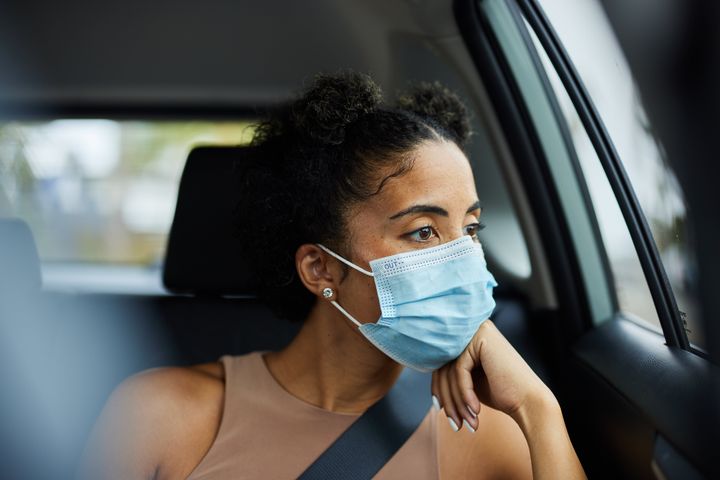
Omicron was only identified by the World Health Organisation in late November but it is already the dominant strain in the UK.
The highly transmissible Covid variant has swept through the country at an alarming rate, pushing the rate of infection up to record levels.
However, there is some cause for optimism, as Omicron is believed to be milder compared to the last dominant variant Delta.
With 90.1% of those aged 12 and over having received at least one dose of the vaccine in the UK, we appear to be in a much better position compared to previous waves of infections – which is why the government is currently sticking to “plan B” restrictions rather than introducing a lockdown.
So here’s breakdown of all the positives – and negatives – surrounding the Omicron wave.
What are the largest concerns?
Hospitals are already struggling
Hospitals are expected to come under “considerable pressure” according to the prime minister, and he said it would a “folly” to think the dangers from the new variant are over.
Admissions are also expected to surge in coming days as the impact of Christmas and New Year celebrations without restrictions reaches the hospital. Students’ return to school is likely to increase case numbers too, as there will be mass indoor mixing.
More than six NHS trusts have already declared critical incidents, while NHS Confederation chief executive Matthew Taylor has claimed that several parts of the NHS were “in a state of crisis”.
Others are questioning what it means for the NHS to be overwhelmed considering appointments have already been cancelled, ambulance response times dramatically extended, and nearly one in 10 NHS staff were off work on New Year’s Eve.
The government has already announced it is building eight new the Nightingale surge hubs, the temporary units used when hospitals cannot cope with its high number of patients.
There are also concerns that the government is not in touch with the latest NHS data. Vaccines minister Maggie Throup was not able to explain how many trusts had declared a critical incident during an interview with Sky News on Tuesday morning, nor how many people were currently self-isolating.
Cases are rising in the elderly
Not only are those aged 65 and over more likely to contract severe symptoms from Covid – meaning they are at higher risk of being hospitalised – but the case numbers are now rising in the older generations.
Nationwide staff absences
A million Brits are currently isolating, meaning public services outside of hospitals are also stretched.
With fewer people able to work, there is an unplanned cut in the supply of goods and services – leading some to call for the government to reduce isolation time from seven days to five.
Vaccine rollout has slowed
Fewer people are taking up the vaccine now, even though December saw the highest number of vaccinations administered since the start of the pandemic.
Still, only 59.3% of the country have received their booster jabs, meaning those without the third jab are less protected against Omicron.
Johnson also claimed that up to 90% of people in intensive care units have not received their booster jabs.
More variants are also likely to emerge, but Sir Andrew Pollard, chief of the Joint Committee on Vaccinations and Immunisation (JCVI), has warned that it will not be possible to vaccinate everyone every six months and that the focus needs to be on the vulnerable.
What can we feel optimistic about?
Infection rates expected to drop soon
Professor Neil Ferguson from Imperial College London, a member of the Scientific Advisory Group for Emergencies, told BBC Radio 4′s Today programme: “I think I’m cautiously optimistic that infection rates in London in that key 18 to 50 age group – which has been driving the Omicron epidemic – may possible have plateaued.”
He suggested that while hospitalisations will stay high for several weeks, case numbers should drop in the next three weeks.
Government insiders have also maintain the data does not suggest the NHS will be overwhelmed, according to POLITICO’s Playbook.
NHS Providers chief executive Chris Hopson also tweeted that “recent London data” suggested it was coping at the moment. Considering the capital went through the Omicron peak first, politicians are likely to look to numbers in London to predict what is happening elsewhere.
He also suggested the primary issue for the NHS was the “number of staff absences and general admissions with Covid, on top of existing pressures”.
Covid-related deaths far below those in first wave
The number of deaths is far below the numbers seen in the first wave, suggesting that vaccines are holding up against severe disease.
John Burn-Murdoch of the Financial Times also tweeted: “The link between cases and severe disease has significantly weakened with Omicron.”
Three studies found that people are 15 to 20% less likely to be admitted to hospital with Omicron compared to Delta in December.
Burn-Murdoch also pointed out that “excess ICU pressure”, has dropped in recent weeks and remains much lower than last year.
What do we need to keep an eye on?
The impact from Omicron in the UK depends on a few particular factors in the coming weeks.
A possible surge in cases following Christmas and New Year mixing could have a far-reaching impact on hospitalisations, as could the return to school.
The ability of the NHS to cope with staff shortages remains a pressing concern, but any early indicators that London has passed its peak in cases could prove promising in the long-run.